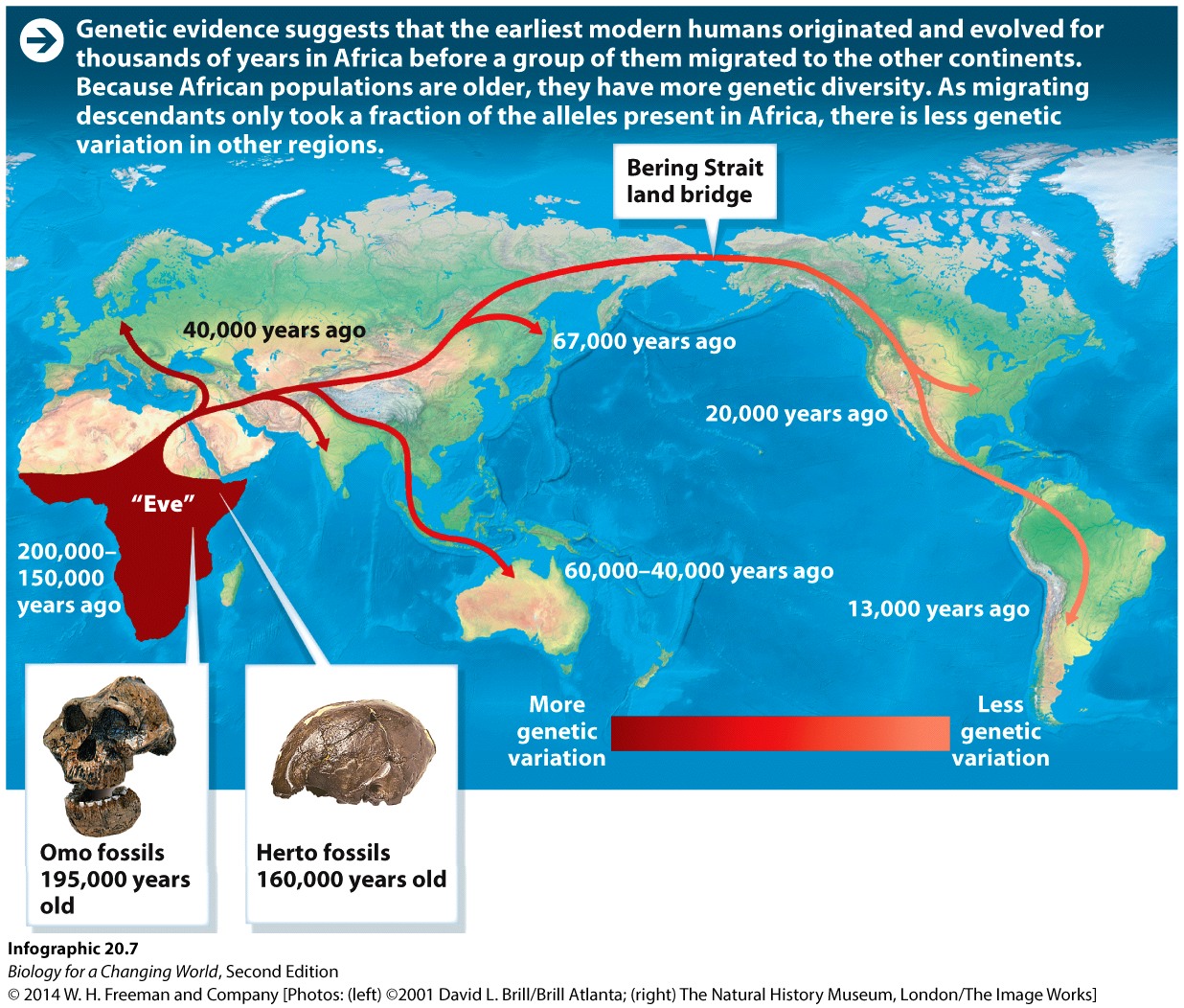
Chapter 1. Chapter 20: Human Evolution
1.1 Introduction


Welcome to the Interactive Study Guide for Chapter 20: Human Evolution! This Study Guide will help you master your understanding of the chapter's Driving Questions, using interactive Infographics and activities, as well as targeted assessment questions. Click "Next" to get started, or select a Driving Question from the drop-down menu to the right.
Skin Deep:
Science redefines the meaning of racial categories
DRIVING QUESTIONS
- What contributes to human skin color and why is there so much variation in skin color among different populations?
- Where did the earliest humans evolve and how do we know?
- What can we learn about human evolution from the fossil record?
1.2 Driving Question 1:
Driving Question 1
What contributes to human skin color and why is there so much variation in skin color among different populations?
Why should you care?
Human skin color has been used for centuries as a way to separate people into groups, as a way to make value judgments about both individuals and groups, and as a basis for stereotyping and discrimination. Understanding the evolutionary significance of skin color allows us to see that a given skin color can’t be “good” or “bad.” Instead, skin color is a trait that is subject to natural selection; the colors we see all have conferred selective advantages in some place at some time.
Is your skin light or dark? Freckled or not? Do you tan easily or burn at the slightest exposure to the sun? These skin characteristics are a function of the type, amount, and distribution of melanin in your skin. Melanin is the pigment molecule found in the skin and hair of all mammals. It comes in two forms, one that produces brown-black colors and one that produces red and yellow colors. Variation in the kind, amount, and distribution of these molecules is responsible for variation in human skin color and tone around the world.
Adequate intake of folate (vitamin B9) and vitamin D is a crucial component of prenatal nutrition because both vitamins play critical roles in fetal development and maternal health. Levels of folate and vitamin D are affected by both skin pigmentation and sunlight. Selection for the appropriate balance of these two nutrients in different environments explains much of the variation in human skin color around the world.
Understanding the selection pressures that have been part of our past and that are with us now can help us understand simple physical traits like skin color and can also help us understand why genetic diseases such as cystic fibrosis and sickle-cell disease persist.
What should you know?
To fully answer this Driving Question, you should be able to:
- Explain how melanin influences skin color.
- Describe the types of birth defects related to folate deficiency and vitamin D deficiency.
- Illustrate and describe the relationship between sunlight (UVB rays), skin color, and folate levels in the body.
- Illustrate and describe the relationship between sunlight, skin color, and vitamin D levels in the body.
- Infer and discuss the combinations of sunlight and skin color that would maintain adequate levels of both folate and Vitamin D in the body.
- Describe the general correlation between skin color and geography (specifically distance from the equator).
- Compare and contrast positive, negative, and neutral selection.
- Diagram and describe the broad pattern of human skin color evolution using the folate–vitamin D hypothesis to explain selection acting on this trait.
Infographic Focus
The Infographics most pertinent to the Driving Question are 20.1 to 20.4, 20.9, and 20.10.
Explain how melanin influences skin color.
1.
Do all individuals produce the same amount and kind of melanin?
No, there are two kinds of melanin and people produce varying levels of the pigment.
2.
Can the environment affect the amount of melanin produced in a person’s skin? Explain.
Describe the types of birth defects related to folate deficiency and Vitamin D deficiency.
3.
List and briefly describe two types of birth defects related to folate deficiency. Be sure your explanation refers to folate’s role in our bodies.
4.
List and describe one threat to maternal health and one risk to children of low Vitamin D levels during pregnancy. Your description should refer to the role of Vitamin D in the body.
Illustrate and describe the relationship between sunlight (UVB rays), skin color, and folate levels in the body.
5.
Illustrate the relationship between sunlight, skin color, and folate levels in the body. Your illustration can take any form (including a table if that’s appropriate), but should include the conditions of strong sun + light skin, strong sun + dark skin, faint sun + light skin, and faint sun + dark skin in some way.
Strong Sun + Dark Skin = No change in Folate Levels
Faint Sun + Light Skin = No change in Folate Levels
Faint Sun + Dark Skin = No change in Folate Levels
6.
Write a short description of the relationship you have illustrated.
Illustrate and describe the relationship between sunlight, skin color, and Vitamin D levels in the body.
7.
Illustrate the relationship between sunlight, skin color, and Vitamin D levels in the body. Your illustration can take any form (including a table if that’s appropriate), but should include strong sun + light skin, strong sun + dark skin, faint sun + light skin, and faint sun + dark skin in some way.
Strong Sun + Dark Skin = ↑ Vitamin D Levels
Faint Sun + Light Skin = ↑ Vitamin D Levels
Faint Sun + Dark Skin = ↓ levels of Vitamin D
8.
Write a short description of your illustration.
Infer and discuss the combination(s) of sunlight and skin color that would maintain adequate levels of both folate and Vitamin D in the body.
9.
Based on your two illustrations above, list and describe the sunlight levels that would best balance levels of both folate and Vitamin D in light skinned people and dark skinned people. Are these combinations found in modern human populations?
Strong Sun + Dark Skin = No change in Folate Levels
Faint Sun + Light Skin = No change in Folate Levels
Faint Sun + Dark Skin = No change in Folate Levels
Strong Sun + Light Skin = ↑ Vitamin D Levels
Strong Sun + Dark Skin = ↑ Vitamin D Levels
Faint Sun + Light Skin = ↑ Vitamin D Levels
Faint Sun + Dark Skin = ↓ levels of Vitamin D
Based on the predictions of the illustrations above, the best combinations of skin color and sunlight levels that provide the best balance of folate and Vitamin D are:
Faint Sun + Light Skin = No change in Folate Levels + ↑ Vitamin D Levels
Strong Sun + Dark Skin = No change in Folate Levels + ↑ Vitamin D Levels
Yes, these combinations are found in modern human populations.
Describe the general correlation between skin color and geography (specifically distance north and south of the equator).
10.
Does skin color, as a general rule, get lighter or darker as you move from the equator to the north and south? Explain.
Compare and contrast positive, negative, and “neutral” selection.
11.
What does “neutral” selection for a trait mean, and what are its results?
12.
As forms of natural selection, both positive and negative selection have features in common. What are they?
13.
The outcomes of positive and negative selection are different – what are they?
14.
Use examples from the text to give a realistic scenario, based on natural selection, for each of the following:
Dark skin becomes more common in a population.
Dark skin becomes less common in a population.
Light skin becomes more common in a population.
Light skin becomes less common in a population.
Diagram and describe the broad pattern of human skin color evolution using the folate/Vitamin D hypothesis to explain selection acting on this trait.
15.
Where did humans originate? What skin color was favored there and why?
16.
What was the second step in human migration? How did that affect skin color in new human populations? That is, what skin color was favored and why?
17.
Once that step happened, did humans ever undergo a “reversal” – that is, migration to a new location and selection for the original skin color? If so, did this happen once, or more than once? Explain.
Thought Question: In modern society, people of all skin colors live on every continent, generally without folate or Vitamin D problems. Why do you think this is?
Review Questions
18.
Which of the following correctly characterizes the melanin-producing cells in our skin?
| A. |
| B. |
| C. |
| D. |
| E. |
19.
A person with light skin tone would be able to live in complete darkness with no ill effects on reproductive success.
| A. |
| B. |
20.
A trait that does not change the frequency of alleles in a population has undergone:
| A. |
| B. |
| C. |
1.3 Driving Question 2:
Driving Question 2
Where did the earliest humans evolve and how do we know?
Why should you care?
Scientists have been trying to understand human evolutionary history at least since the time of Darwin. One of the many lively debates in the field has been about when and how often anatomically modern humans (early Homo sapiens) migrated out of Africa to colonize the rest of the globe. The Mitochondrial Eve study was one piece of evidence supporting the hypothesis that all human populations share a single African origin and that all non-African populations arose from a single migration 150,000 to 200,000 years ago. The evidence comes from a study of mitochondrial DNA (mtDNA), which is maternally inherited. Mitochondrial DNA is a powerful tool in studying human evolution, not only because it is maternally inherited, but also because its relatively small genome has a relatively high mutation rate compared to nuclear DNA. Using samples from 147 people from around the world, investigators constructed a family tree of mtDNA; that tree converged on an African ancestor—more specifically, the most recentwoman from whom we have all inherited our mtDNA. Then investigators calculated the amount of variation in the mtDNA. By comparing it to known rates of change, they were able to estimate when that ancestor lived.
What should you know?
To fully answer this Driving Question, you should be able to:
- Explain the mechanism behind maternal inheritance of mtDNA.
- Compare and contrast nuclear DNA ancestry with mtDNA ancestry.
- Explain who Mitochondrial Eve was and why she is significant to understanding human evolutionary history.
Infographic Focus
The Infographics most pertinent to the Driving Question are 20.5 to 20.8.
Explain the mechanism behind maternal inheritance of mtDNA.
21.
Do eggs have mitochondria? Do sperm?
22.
Why is mtDNA only inherited from the mother?
Compare and contrast “nuclear DNA ancestry” with “mtDNA ancestry.”
23.
In your notebook, draw a hypothetical family tree of a single individual that includes parents, grandparents, and great-grandparents (no brothers/sisters). Be sure to distinguish between males and females.
24.
Bearing in mind that an individual’s nuclear DNA comes from every ancestor, how many “nuclear DNA ancestors” are present in the generation of great-grandparents?
Eight ancestors
25.
Remember that mtDNA is inherited through mothers only. Draw a line connecting the individual back to the source of his/her mtDNA. How many “mtDNA ancestors” does the individual have?
Three ancestors
26.
Is/are the “mtDNA ancestor(s)” the only actual (individual) ancestor(s) of her generation?
Yes
27.
Based on your answers, write a sentence describing the difference between nuclear and mitochondrial DNA ancestry.
You inherit your nuclear DNA from all ancestors both male and female. This is different from the inheritance pattern for mtDNA where you inherit your mtDNA from your mother, who inherited hers from her mother (your grandmother), who in turn inherited hers from her mother (your great-grandmother). So only the female ancestors on your mother’s side would contribute to your mtDNA ancestry.
Explain who Mitochondrial Eve was and why she is significant to understanding human evolutionary history.
28.
How would you explain Mitochondrial Eve to someone who didn’t know anything about human evolution? In one or two sentences, explain who Mitochondrial Eve was. Be precise.
29.
What important question or questions did the identification of Mitochondrial Eve” answer?
Review Questions
30.
A woman and a man have 4 children: 2 sons and 2 daughters. Each child marries and has 3 children. How many of the grandchildren share the woman’s mtDNA?
| A. |
| B. |
| C. |
| D. |
| E. |
31.
A son has his mother’s mtDNA.
| A. |
| B. |
32.
A son is able to pass on his mother’s mtDNA to his daughter.
| A. |
| B. |
1.4 Driving Question 3:
Driving Question 3
What can we learn about human evolution from the fossil record?
Why should you care?
One of the most common misconceptions about human evolution is that we are the product of a single straight branch of evolution rather than the sole remaining twig of an evolutionary tree that is at least 5 million years old. The more fossils we discover and study, the more we are learning about the sequence of evolutionary events that led to the suite of characteristics that define us as a species.
For years, scientists have been using a number of tools, including studies of mtDNA and fossils, to clarify when and how humans left Africa and colonized the rest of the globe. Our understanding of these patterns in turn can be used to help us understand patterns of natural selection and cultural evolution, including the evolution of language.
What should you know?
To fully answer this Driving Question, you should be able to:
- Describe the migration of humans out of Africa and use the pattern of dispersal to answer questions about human evolution.
- Interpret a human phylogeny to answer questions about human evolution.
Infographic Focus
The infographics most pertinent to the Driving Question are 20.7 and 20.8.
Test Your Vocabulary
Choose the correct term for each of the following definitions:
| Term | Definition |
|---|---|
| A fat-soluble vitamin required to maintain a healthy immune system and to build healthy bones and teeth. The human body produces vitamin D when skin is exposed to ultraviolet light. | |
| Pigment produced by a specific type of skin cell that gives skin its color. | |
| Any living or extinct member of the family Hominidae, the great apes— humans, orangutans, gorillas, chimpanzees, and bonobos. | |
| A B vitamin also known as folic acid. Folate is an essential nutrient, necessary for basic bodily processes such as DNA replication and cell division. | |
| The DNA in mitochondria that is inherited solely from mothers. |
Describe the migration of humans out of Africa and use the pattern of dispersal to answer questions about human evolution.
33.

Approximately when did humans reach each of the following regions, based on the information in Infographic 20.7?
| Far eastern Asia: |
Fill in: |
| Western Europe: |
Fill in: |
| North America: |
Fill in: |
| Australia: |
Fill in: |
Western Europe: 40,000 years ago
North America: 20,000 years ago
Australia: 60,000 - 40,000 years ago
34.
In what region of the world would you expect to find people with the greatest mixture of genetic traits: from Africa, Asia, or Europe? Why?
35.
Bearing in mind that the amount of genetic variation in a population increases with its age, in what region would you expect to find the least genetic variation according to this map? The most variation?
Interpret a human phylogeny to answer questions about human evolution.
36.
About how long ago did we start walking upright? (hint: check the text to find the name of the important fossil)
37.
How many major branches of our evolutionary tree arose after Australopithecus afarensis (the famous “Lucy” fossil) existed? How did the members of those branches differ, according to the pictures on the phylogeny?
38.
During which 2-million year time period did we have the greatest diversity (number of species) of hominids in Africa? Justify your answer.
39.
Recent evidence from sequencing the Neanderthal genome suggests that modern humans carry Neanderthal DNA in our nuclei. Does that change the way this diagram should be drawn? Why or why not?
Review Questions
40.
Which population would have likely developed light skin coloring last?
| A. |
| B. |
| C. |
| D. |
41.
Humans evolved from Chimpanzees.
| A. |
| B. |
42.
How many species is/are a direct descendent of Mitochondrial Eve?
| A. |
| B. |
| C. |
| D. |
Activity results are being submitted...